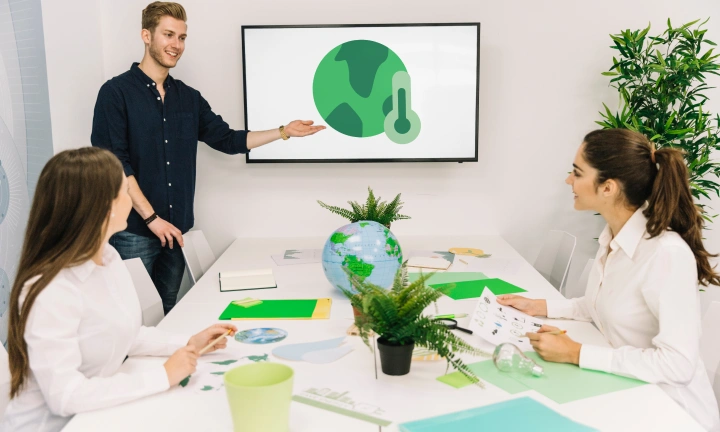While the effects of COVID-19 has lowered world carbon pollution, we still continue to be on a catastrophic trajectory.
We cannot continue living and earning a livelihood while remaining unbothered by the prevailing situation, just like we have been doing so far.
The current situation requires everyone at all tiers and throughout organizations, sectors, and locations to genuinely accelerate the pace of transformation. Today, it’s essential to have solutions that are reliable and work fast. Practically visible results based on concrete measures are now necessary.
Looking at the demand of the current situation, SAP has taken an impactful initiative by introducing the SAP Climate 21 Program to fight these challenges.
What is the Climate 21 Solution?
SAP’s Climate 21 initiative has already supported organizations with improved durability since its launch.
Throughout the last decade, several corporations have been trying to focus on decreasing carbon dioxide emissions. SAP’s Climate 21’s latest accomplishment and collaboration further strengthen the vision, focusing on the impact of different industrial sectors on the environment.
Christian Klein, the SAP CEO, noted that they are trying to assist companies in tackling the climate change mitigation dilemma. One of his recent posts on LinkedIn addressing the matter said:
“As we run the supply chains of the largest companies in the world, we can play a central role in helping companies manage their green line by minimizing the carbon footprint and negative environmental impact of their products.”
With its latest offering, SAP is enabling companies to alter their existing business strategies towards sustainability and improving their carbon footprint. This has played a vital role in helping companies meet the net-zero carbon footprint targets.
Apart from this, SAP has committed itself to emissions reduction in its activities by the ending of 2023. The corporation promotes the Sustainability Objectives issued by the United Nations General Assembly with a singular emphasis on climate change initiatives and achieving sustainability goals.
Why did SAP find it necessary to initiate a climate action?
The need for a global climate action strategy
The primary reason for SAP’s climate 21 initiative is the immediate need to reduce carbon dioxide emissions to create a sustainable environment. We need to reduce carbon dioxide emission by 50% over the next decade to maintain the 1.5 degrees CO2e pathway.
Locally arising issues are forcing companies to design and strategize globally impactful climate action with better transparency. A simple annual GHG (Green House Gas) report is no longer enough to handle the need for effective climate action.
The impact of sustainability trends on transforming industrial market
- More investors are trying to integrate ESG (Environmental, Social, and Governance) criteria into their investment decisions. 76% growth of investors integrating ESG in business strategies.
- Consumers are choosing to rely on products or services that are more sustainability friendly and show that they care for the environment. About 42% of consumers usually walk away from companies and brands that are not environmentally friendly.
- Employees are supporting their employer company’s environmentally impactful initiatives. 15% of employees working in Fortune 1000 companies support the actions of their employees on different environmental issues.
- Climate action has become a focus on almost every CEO agenda.
Organizations and world leaders take initiatives to fight environmental crisis
Several companies and brands have taken practical initiatives to stand with climate action to reduce CO2 emissions. Such as:
- Allianz no longer gives insurances to facilities that run on coal-fired energy
- Walmart has taken carbon dioxide out of their supply chain
- MAERSK is going to introduce zero-emission vessels
Some other mentionable brands and companies that have taken on green initiatives are BlackRock, Toyota, Nike, McDonald’s, etc.
The Objective of Climate 21
Listed below are the objectives of Climate 21, based on different levels of operation:
Economical
- To become a sustainable investment strategy
- Help the companies to build market strategies, business practices, and functions that comply with climate-based laws and regulations
- Protect a business’s “license to operate” in the long term
Ecological
- Honor the 2030+ carbon reduction promises
Social Benefits
- Create a better and livable planet for our future generations
And all these objectives come together to promote the primary objective:
Fighting Climate Change through controlling CO2e emissions
Climate 21: Vision and Actions
SAP plans to include environmentalism into analytical and interactive systems as a new dimension of success. It will help to create intelligent organizations that decrease CO2e throughout the complete supply chain – from beginning to end.
Climate 21 initiates a 3-step plan to fulfill this vision. It conducts this entire operation using different SAP application services.
- Assess the inventory and the climatic impact of your products and services
- Analyze and find a way to minimize the carbon footprint of the materials, goods, and services used.
- Optimize by making changes in the services, goods, business plan, and business models.
The Different actions that can be taken to chase the Climate 21 vision:
- Design and strategize business processes and products to minimize carbon footprint
- CO2e optimized packing
- Create Sustainable Market for business
- CO2e optimized supply management
- Operate Emission and waste management
- CO2e optimized transport
- Energy-efficient manufacturing planning and scheduling
- Energy-efficient warehouses
- Promote business sustainability image
- Create Sustainable Consumer service and support
- Complete Carbon footprint disclosure
- Evaluate and project the financial impact
- Promote return and recycling
The end-to-end CO2e transparency
The SAP Application service, Carbon Footprint Analytics, enables complete CO2e transparency throughout the entire supply chain.
Companies/ Enterprises:
Protect the need to continue operating via flexible carbon regulatory business strategies, commodity portfolios, and procedures.
Business Functionality:
Monitor and optimize the carbon footprint commodities and operations from start to end.
Consumers:
Enable customers with carbon footprint knowledge on goods and service providers to make ethical purchase choices.
The SAP Climate 21 Road Map
SAP Climate 21 implementation plans going forward:
2020: Intimating Assessment phase using SAP product Carbon Print Analytics
2021: Evaluating Carbon Account and Analyzing finance
2022: Optimizing Operations and Value chain
2023: Integrate into Business planning, Industry 4.0, and Product planning using a Sustainable Intelligent Suite
Conclusion
The inclusion of a company-wide strategy for CO2 reduction, through a solution like Climate 21, will assist enterprises to become more transparent and environmentally conscious. It will also provide the organization with an additional economic incentive to act immediately. The SAP Climate 21 represents our willingness to adapt for the betterment of the world. We are living in an era of change, and SAP is ready to sustain it.

